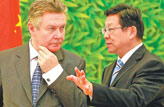Money
Yuan hits new high
Updated: 2011-07-22 09:08
(Xinhua)
It indicates a 22-percent increase after the country launched exchange reforms on July 21, 2005. The ratio was 8.11 yuan per US dollar when the reforms were launched six years ago.
The RMB, or yuan, has appreciated in an unilateral way and anticipation on this is attracting more capital inflow, burdening domestic liquidity management, said Chen Bingcai, a researcher with the National School of Administration.
The yuan's unilateral appreciation has brought challenges such as global payment imbalances, soaring foreign exchange reserves, inflows of speculative "hot money" and high trade costs for exporters.
Troubles brought by the unilateral appreciation are more serious than those caused by pegging the yuan to the US dollar, said Lu Zhengwei, a senior economist with the Industrial Bank.
The yuan's real effective exchange rate (REER) went up 14 percent in the past six years, far below the yuan's appreciation against US dollar, according to the Bank for International Settlements (BIS).
The yuan's REER currently stands at 116.31, up from 101.42 when China launched the exchange reforms six years ago, according to the BIS. Meanwhile, the ratio of yuan against the US dollar rose 2.45 percent this year, but the yuan's REER actually depreciated 3.02 percent.
The REER index of the yuan is used to measure the yuan's external competitiveness vis-a-vis the currencies of the country's major trading partners and competitor exporter countries.
A hike in the REER index would mean the currency is appreciating on a real, trade-weighted basis, suggesting a loss in external price competitiveness.
China faces risks from inflation and a possible boom and bust in real estate prices and should allow its currency to rise to promote economic stability, the International Monetary Fund said in an annual review on Wednesday.
It said a stronger yuan is "a key ingredient to accelerate the transformation of China's economic growth model."
China abandoned a decade-old peg to the US dollar by allowing its currency to fluctuate against a basket of currencies on July 21, 2005.
The reforms were suspended in a bid to fight the global downturn in 2008. The yuan exchange rate again was pegged to the dollar at a ratio around 6.83 from September 2008.
The peg was lifted on June 19, 2010, when the central bank announced further yuan exchange rate formation mechanisms.
In China's foreign exchange spot market, the yuan is allowed to rise or fall by 0.5 percent from the central parity rate each trading day.
The central parity rate of the yuan against the US dollar is based on a weighted average of prices before the opening of the market each business day.

Specials

China-US Governors Forum
The first China-US Governors Forum is held July 15 in the Salt Lake City, the United States.

My China story
Foreign readers are invited to share your China stories.

Rare earths export quota
China kept its export quota at almost the same level as last year.